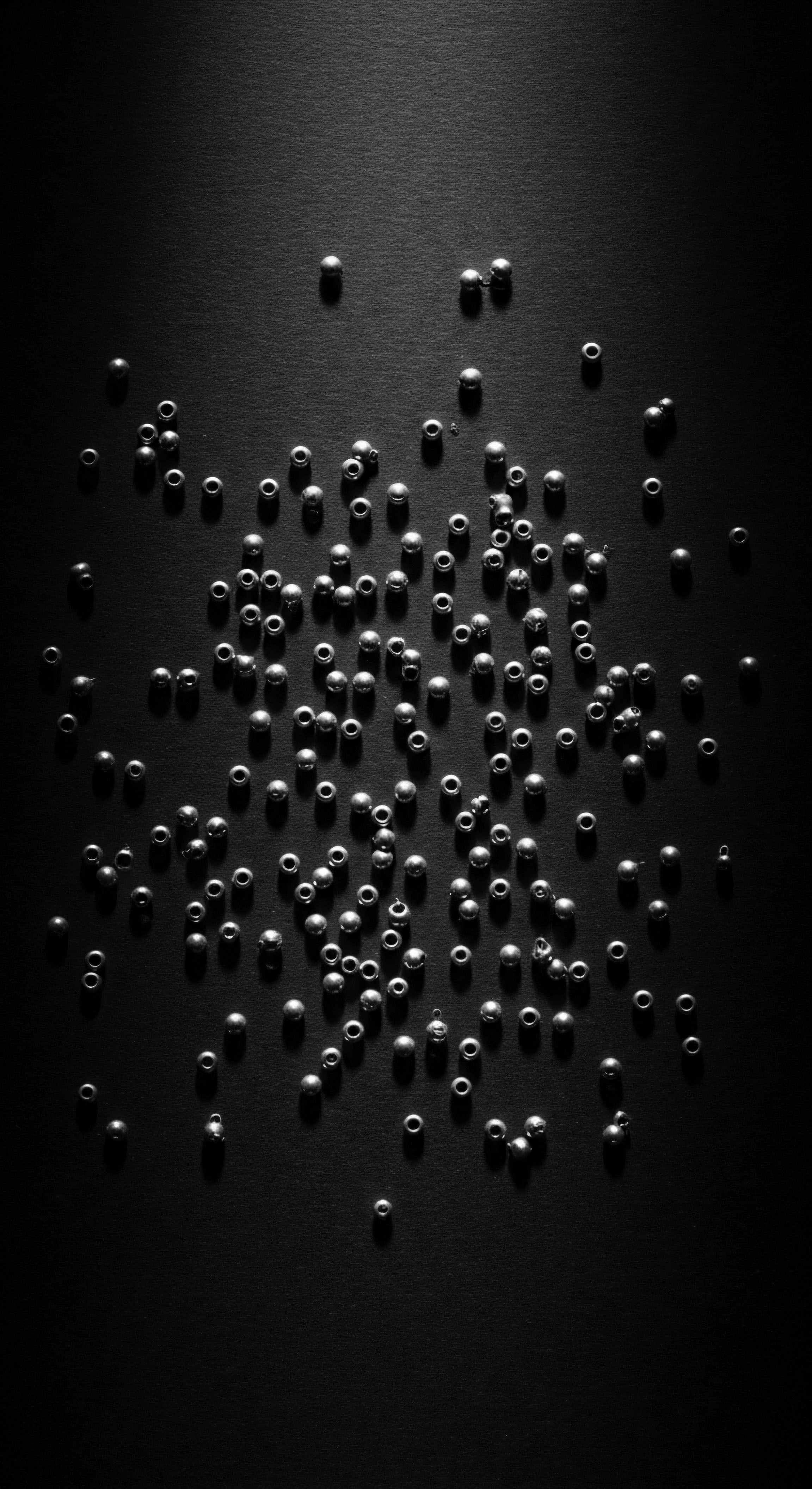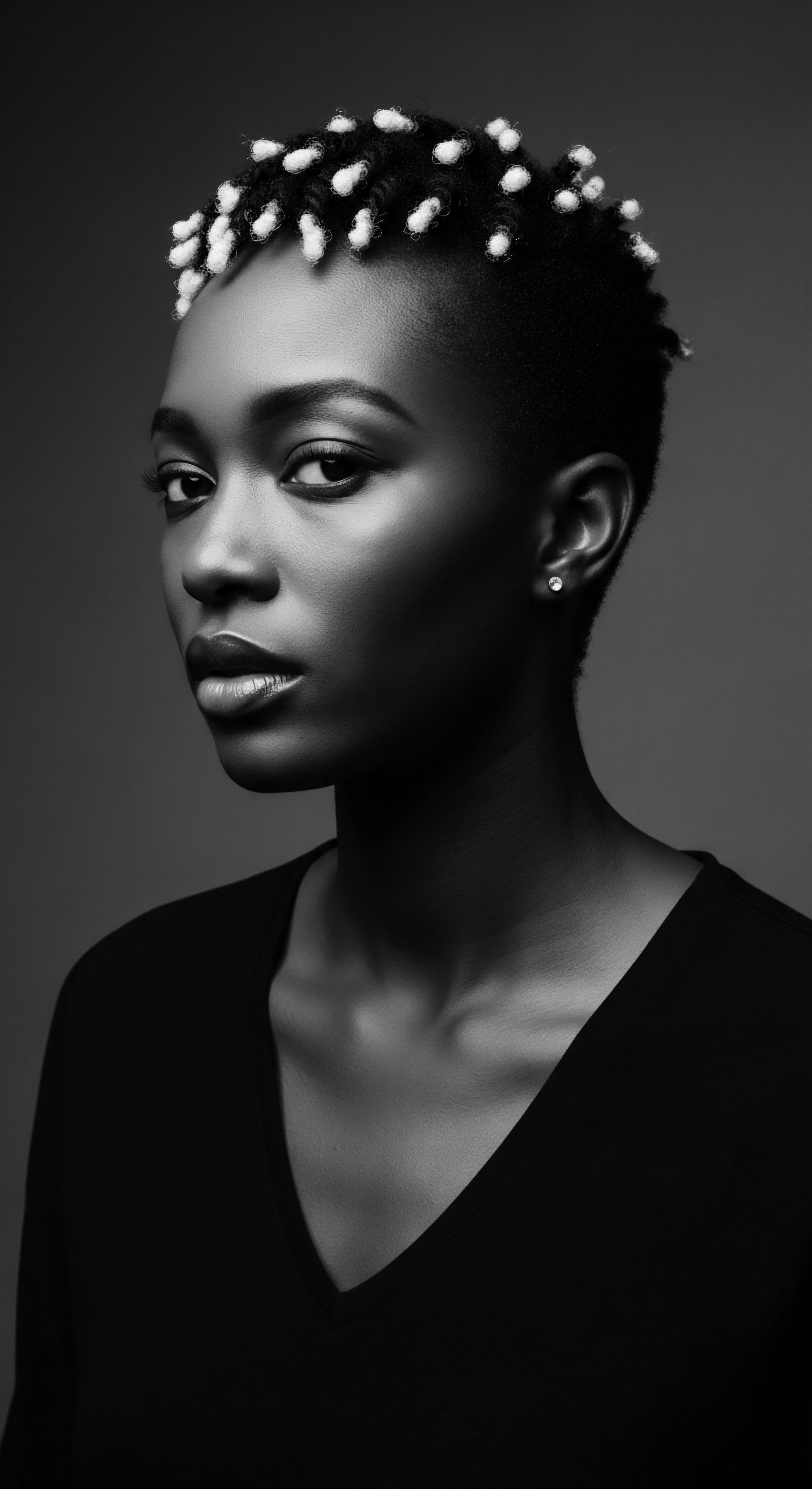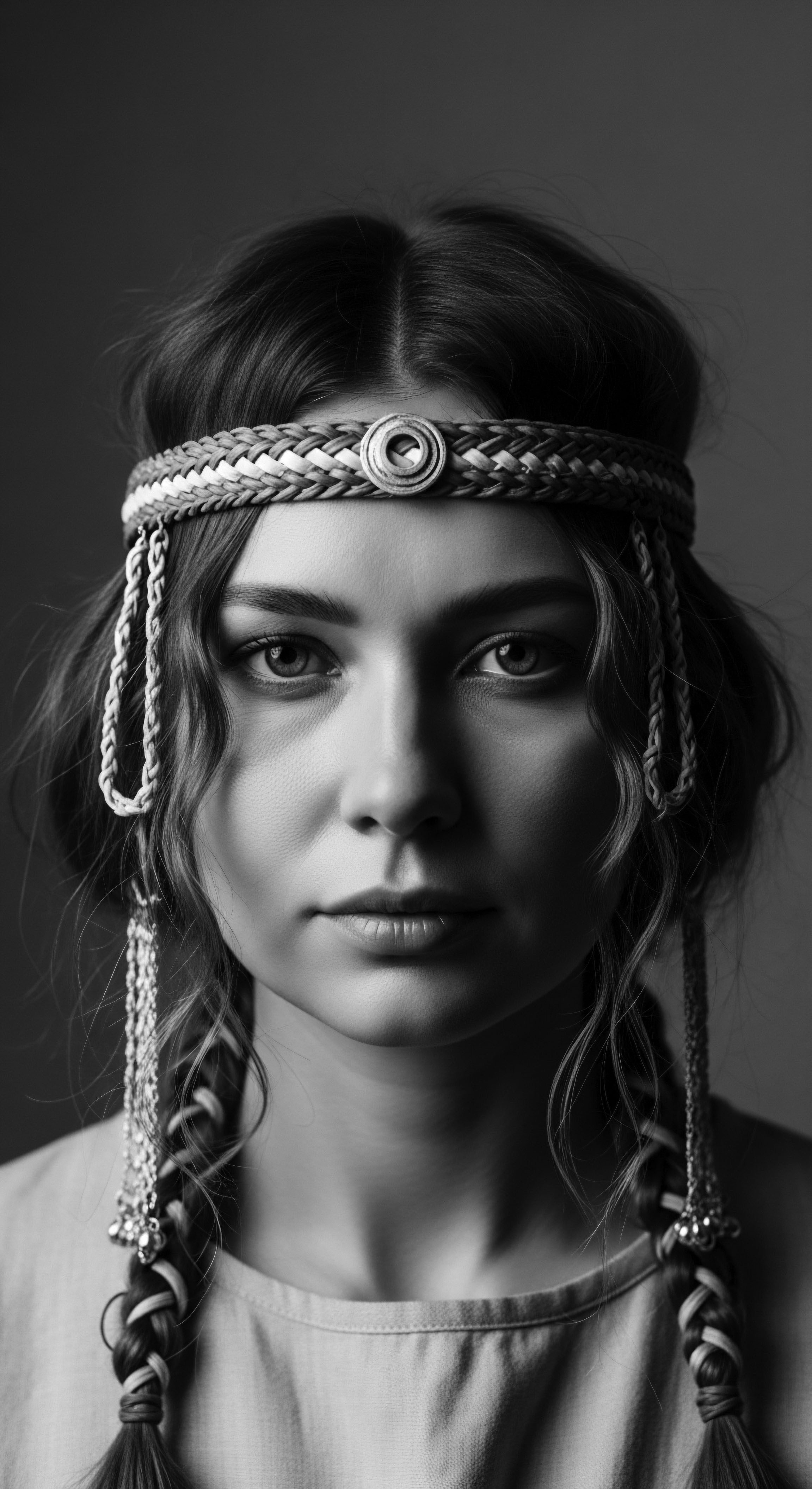
Roots
The very strands of our textured hair hold more than mere protein and pigment; they are living archives, tracing lineages back through countless generations. They hum with ancestral memory, carrying the wisdom of those who walked before us, whose understanding of care was born from intimate observation of sun, wind, and earth. For those with coils, kinks, and waves, hair has always possessed a profound identity, a visible connection to spirit and community. It is a part of ourselves that often faces the world unprotected, yet for centuries, a simple, yet profound, act offered sanctuary ❉ the donning of a head covering.
This ancient practice, far from a mere adornment, served a deeper purpose. It was a shield, a cocoon, a testament to inherited knowledge regarding the vitality of our hair. Can these traditional head coverings truly prevent textured hair damage? To answer this, we must journey back to the elemental biology of our hair, viewing it not as a scientific curiosity alone, but as a biological marvel steeped in cultural significance and the deep wisdom of those who perfected its keeping.

Hair Anatomy and Its Ancestral Understanding
The biology of textured hair presents distinct characteristics that render it particularly vulnerable to mechanical stress and environmental assault. Unlike straight hair, which tends to have a circular or oval cross-section, coily and kinky strands possess a flatter, elliptical shape. This structural asymmetry means the cuticle layers, those protective scales that lie flat on straight hair, tend to lift and separate more readily along the strand’s natural curves.
Such lifted cuticles result in increased porosity, making textured hair more prone to losing moisture and absorbing environmental pollutants. The bends and turns of each curl also create points of weakness, where tangles form easily and breakage can occur with friction.
Long before microscopes revealed cellular structures, our ancestors understood these inherent vulnerabilities through lived experience and keen observation. They noticed how sun parched hair, how winds frayed it, and how dust settled deep within its intricate patterns. Their solutions were not accidental; they were carefully calibrated responses to the hair’s innate needs.
The choice of fabric, the manner of wrapping, the oils applied beneath—all spoke to a sophisticated, albeit unwritten, understanding of hair’s fragility and its need for external protection. This knowledge became a core part of their daily existence, a quiet yet powerful affirmation of self-preservation.
Ancestral wisdom about textured hair’s inherent vulnerabilities led to ingenious protective practices, including head coverings, long before modern science articulated the reasons why.

Textured Hair Classification and Cultural Meanings
The contemporary systems we employ to classify textured hair—from type 3A to 4C—are relatively recent inventions, attempting to categorize the immense diversity within Black and mixed-race hair. Yet, long before these charts, communities held their own, unspoken classifications. Hair texture often signified tribal identity, marital status, or social standing. The way hair was styled, adorned, or covered communicated volumes without a single word.
Certain textures might have been associated with specific spiritual practices, others with warrior status, still others with fertility. These cultural categorizations, though not scientific in our modern sense, carried profound implications for care.
Consider the protective styles that so often accompany head coverings ❉ cornrows, braids, twists. These styles, ancient in their conception, are not merely aesthetic; they meticulously organize and secure the hair, minimizing friction between individual strands and reducing exposure to the elements. Head coverings then act as a second layer of defense, especially during rest or demanding tasks. The combination of an intricately woven protective style beneath a carefully draped cloth represented a holistic approach to hair preservation, a testament to the integrated nature of beauty, spirit, and health.

Can Environmental Factors Shape Hair’s Structure Over Generations?
It is compelling to consider how persistent environmental factors across millennia might have influenced the very evolutionary trajectory of textured hair. In regions of intense sun and arid winds, the tightly coiled structure, while appearing delicate, offered a degree of protection to the scalp by creating a dense canopy that shielded from direct UV radiation. The scalp, rich with blood vessels, plays a vital role in thermoregulation.
A compact mass of hair could help regulate heat and prevent sun damage to the scalp itself. However, this natural shield came with its own set of care requirements.
The need for moisture retention in dry climates, for instance, drove the use of various plant-based oils and butters—shea, palm, coconut—often applied before or after hair was covered. This synergy between natural ingredients, the hair’s intrinsic architecture, and external coverings speaks to a profound ecological harmony. These are not isolated practices; they are interwoven aspects of a life lived in tune with natural rhythms and the specific needs of the body, recognizing that healthy hair was a sign of vitality and well-being within the community.
- Kinky Hair ❉ Characterized by tight, often zig-zag patterns, these strands are typically very fine but densely packed, requiring significant moisture retention.
- Coily Hair ❉ Forms spring-like spirals, ranging from loose curls to pencil-sized coils, often prone to shrinkage and dryness.
- Wavy Hair ❉ Possesses a distinct ‘S’ pattern, often smoother than coily or kinky textures but still benefiting greatly from protective measures.
The knowledge of how to care for these varied textures was passed orally, through hands-on teaching within families and communities. The simple head wrap, made from readily available fabrics, became an accessible and universally practiced tool in this ancestral regimen, ensuring that despite the rigors of climate or daily toil, the hair remained nourished and intact. This unbroken chain of knowledge, rooted in the very beginnings of our collective memory, confirms the head covering’s place not just as a fashion item, but as a tool of preservation, a silent guardian of hair heritage.

Ritual
The act of adorning the head with fabric, whether a brightly colored scarf for a market day or a simple cloth for slumber, represents far more than a momentary fashion choice. It is a ritual, a deliberate engagement with cultural memory and ancestral care. These practices, honed over centuries, demonstrate a profound understanding of how to manage and preserve textured hair across various life stages and environmental conditions. The head covering, in its many forms, became a central element in a sophisticated system of hair management that balanced aesthetics with genuine protection.

Protective Styling and Ancient Roots
Long before terms like “protective styling” entered our contemporary lexicon, the concept was inherently understood and meticulously practiced across Africa and the diaspora. Styles such as braids, twists, and cornrows, often intricate and time-intensive, were not merely decorative. They served a vital purpose ❉ to minimize manipulation, reduce tangling, and keep fragile ends tucked away from damage.
A head covering, whether a flowing head wrap or a fitted cap, served as a crucial reinforcement to these styles. It shielded them from external aggressors—dust, grime, harsh sunlight, or even the friction of daily activities—thereby prolonging their protective benefits.
Consider the women of the Mbalantu people in Namibia, whose elaborate dreadlocks, often extending to incredible lengths with the help of fibrous extensions, were a symbol of status and beauty. These magnificent tresses were painstakingly maintained and frequently protected by intricate coverings and headpieces, especially when working or during travel. The covering was not an afterthought; it was an integral part of maintaining the hair’s integrity, preventing the accumulation of debris and minimizing wear and tear over months or even years. This long-term commitment to hair preservation, aided by deliberate covering, speaks to a deep, practical wisdom.
The synergy between a well-executed protective style and a quality head covering cannot be overstated. It is a two-pronged approach that significantly reduces exposure to elements that cause dryness, breakage, and dullness. The physical barrier prevents direct sun exposure, which can degrade hair protein and lighten color.
It wards off wind, which causes tangles and moisture loss. And at night, it cradles the hair against the abrasive surfaces of pillows, a silent battle won against friction-induced breakage.

What Role Did Head Coverings Play in Historical Definitions of Beauty?
Throughout history, the aesthetics of covered hair often intertwined with its practical benefits. In many cultures, the head wrap transitioned from a utilitarian item to a powerful statement of identity, spiritual devotion, or social standing. The vibrant patterns and diverse draping techniques of the West African gele , the turban traditions of various global communities, or the simple kerchiefs worn by enslaved women as a mark of dignity and resilience—all carry layers of meaning beyond mere protection. While practicality certainly drove their adoption, their evolution into symbols of beauty and defiance is equally significant.
This duality—practicality meeting cultural expression—is precisely what strengthens the argument for their damage-preventing capabilities. When something is deeply integrated into daily life and holds profound cultural significance, its use is consistent and widespread. This consistent use provides ongoing defense for the hair. For example, during the transatlantic slave trade, head wraps became a means of maintaining dignity and cultural connection amidst brutal dehumanization.
While forced upon them in some contexts, Black women transformed the head wrap into a symbol of resilience and artistry, often using salvaged fabrics to protect their hair from the harsh conditions of labor and sun exposure (White, 2014, p. 57). This historical example poignantly illustrates how head coverings, born of necessity and survival, became enduring instruments of hair preservation and identity.
The use of head coverings also extended to practical application of hair treatments. Before modern processing, hair treatments involved hours, sometimes days, of deep conditioning with natural ingredients like clay , herbs , or oils . A covering would not only protect the treated hair from external elements but also create a warm, enclosed environment, helping the treatment penetrate deeper into the hair shaft. This created a microclimate that maximized the efficacy of the chosen restorative concoction, a practice echoed in today’s deep conditioning rituals where heat caps are often employed.
| Cultural Practice West African Gele |
| Historical Context Ceremonial, daily wear for women, often signifying status or occasion. |
| Hair Protection Benefit Shields hair from sun, dust; preserves intricate protective styles beneath. |
| Cultural Practice Zulu Isicholo |
| Historical Context Large, elaborate headwear, worn by married women in Zulu culture. |
| Hair Protection Benefit Protects delicate hair from environmental damage, maintains styled hair. |
| Cultural Practice Black American Head Wraps |
| Historical Context Historically, during enslavement for practicality and later as cultural statements. |
| Hair Protection Benefit Guarded against harsh labor conditions, maintained moisture, asserted dignity. |
| Cultural Practice These varied practices underscore the enduring link between cultural identity and practical hair care through head coverings. |
The choices made by our forebears regarding their hair were always deeply purposeful, reflecting a synthesis of environmental necessity, spiritual belief, and communal identity. The ritual of covering the head is a testament to this holistic understanding, a silent guardian against the relentless forces of degradation, ensuring the vitality and continued beauty of textured strands for generations to come. This legacy of care, embodied in the simple head covering, continues to resonate today.

Relay
The wisdom embedded in traditional head covering practices is not confined to the annals of history; it acts as a living relay, transmitting essential care principles from one generation to the next. Modern hair science, with its nuanced understanding of molecular structures and environmental impacts, often validates and clarifies the effectiveness of these ancestral rituals. The conversation between the old ways and current knowledge offers a robust answer to whether traditional head coverings truly prevent textured hair damage ❉ they absolutely do, and often with an elegant simplicity that modern solutions sometimes overlook.

What Makes Nighttime Protection So Important for Textured Hair?
The nighttime hours, when we are at rest, might seem benign, yet for textured hair, they present a significant challenge. Cotton pillowcases, though soft to our skin, are inherently absorbent and possess a rougher surface at a microscopic level. As we toss and turn through the night, our hair rubs against this fabric, leading to several forms of damage.
This friction can lift the delicate cuticle layers, causing frizz, tangles, and ultimately, breakage. Moreover, cotton wicks away precious moisture from the hair shaft, leaving strands dry, brittle, and susceptible to further harm.
This is where the ancient wisdom of nighttime protection, particularly the “bonnet wisdom,” shines. Traditional silk or satin head coverings—or even simple cotton ones specifically designed for hair protection—create a smooth, non-absorbent barrier between the hair and the pillow. Silk and satin, with their tightly woven, smooth fibers, minimize friction, allowing hair to glide freely rather than snagging.
They also do not absorb moisture from the hair, thus preserving its natural oils and applied products. This simple act of covering the hair at night acts as a powerful preventative measure against mechanical stress and moisture loss, two primary culprits of textured hair damage.
The selection of fabrics for head coverings, whether for daily wear or nighttime ritual, reflects a thoughtful consideration of hair health.
- Silk ❉ Known for its smooth surface and protein structure, silk reduces friction and retains moisture, making it ideal for delicate hair.
- Satin ❉ A synthetic alternative to silk, satin offers similar smoothness and low absorbency, providing comparable protective benefits at a more accessible cost.
- Cotton (Certain Weaves) ❉ While general cotton is absorbent, some traditional wraps used softer, tightly woven cottons that still offered physical protection from sun and dust, especially when layered or treated with conditioning agents.

Can Ancestral Wellness Philosophies Deepen Hair Care?
Hair care, in many ancestral wellness philosophies, was never isolated from the well-being of the entire person. It was a reflection of internal health, emotional state, and spiritual harmony. This holistic approach means that protective practices like head coverings were part of a larger regimen that included nutritious diets, stress reduction, and communal support. The physical act of covering the hair was often accompanied by spiritual intentions or blessings, imbuing the practice with additional layers of meaning and care.
For instance, traditional African medicine often connects elements of the body, mind, and spirit. When discussing hair health, practitioners might consider not only external treatments but also internal balance, the foods consumed, and even emotional peace. A head covering, in this context, becomes a tool for holistic care—it protects the physical strands, yes, but its ritualistic donning can also serve as a moment of mindfulness, a brief pause to connect with self and heritage. This deeper connection can inadvertently reduce stress, which in itself can impact hair health, demonstrating the profound interplay between mind, body, and fiber.
The journey of a strand, from its follicular roots to its visible length, is a testament to resilience, but also to its constant need for thoughtful preservation. Traditional head coverings, honed through centuries of practical application and cultural wisdom, provide a robust, heritage-backed solution to the daily challenges textured hair faces. They act as guardians against environmental aggressors, minimize mechanical stress, and maintain vital moisture levels.
In this regard, these ancient practices are not merely historical footnotes; they are enduring truths, providing a powerful, accessible answer to the intricate question of how to genuinely protect textured hair. The continuum of care, stretching from the hands of our ancestors to our own, finds a powerful symbol in the humble, yet mighty, head covering.
Traditional head coverings are a testament to ancestral ingenuity, providing a practical and culturally significant barrier against environmental damage and mechanical stress for textured hair.
| Traditional Method Wearing a silk or satin head wrap at night. |
| Mechanism of Protection Creates a smooth, low-friction surface; prevents moisture absorption from pillow. |
| Modern Scientific Validation Reduces cuticle lifting, minimizes tangles, preserves hair’s natural oils and hydration. |
| Traditional Method Protective styles (braids, twists) under coverings. |
| Mechanism of Protection Minimizes exposure of hair ends; reduces daily manipulation. |
| Modern Scientific Validation Lessens mechanical stress, prevents breakage from styling, maintains length retention. |
| Traditional Method The enduring wisdom of protective coverings finds strong support in contemporary understanding of hair fiber mechanics. |

Reflection
Our exploration of head coverings for textured hair has been a journey into the heart of ancestral knowledge, a living archive where every strand recounts a story of preservation and strength. These time-honored coverings are more than simple fabric; they are a profound connection to the ingenuity of those who came before us, a tangible link to a heritage of care passed down through generations. They stand as enduring symbols of resilience, not only protecting the physical integrity of our hair but also safeguarding cultural identity and the sacred connection to our roots.
The efficacy of these traditional practices, reaffirmed by scientific understanding, reminds us that the quest for hair vitality often leads back to the elegant simplicity of ancient ways. The ‘Soul of a Strand’ whispers that true care resides not just in what we apply, but in how we honor and protect the inherent beauty and historical weight of our coils, kinks, and waves. As we look to the future of textured hair care, we are gently guided by the enduring wisdom of the past, seeing the head covering not as a relic, but as a timeless tool, a continuous relay of ancestral love and profound understanding.

References
- White, Shane. 2014. Stylin’ ❉ African American Expressive Culture from Its Beginnings to the Zoot Suit. Cornell University Press.
- Byrd, Ayana. 2008. Hair Story ❉ Untangling the Roots of Black Hair in America. St. Martin’s Press.
- Patton, Tracey. 2006. African-American Hair as Culture and Commodity. Journal of Black Studies.
- Banks, Ingrid. 2000. Hair Matters ❉ Beauty, Power, and the Politics of Hair in African American Women. New York University Press.
- Tollefson, Kristen. 1989. The Hair and the Head in African Societies ❉ A Symbol of Status and Identity. African Arts.
